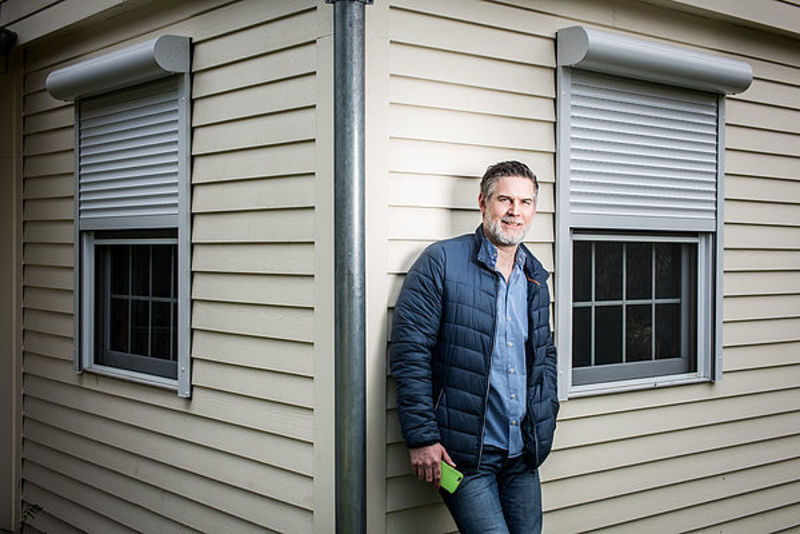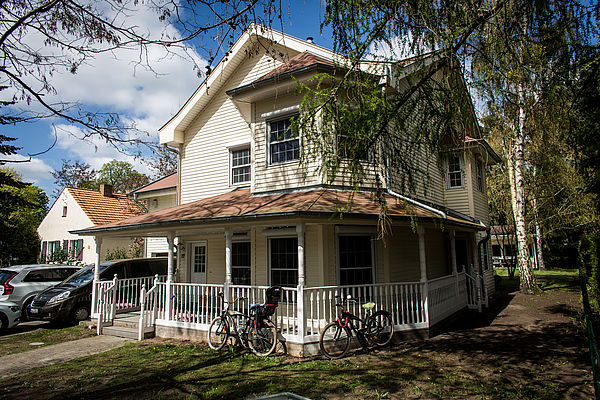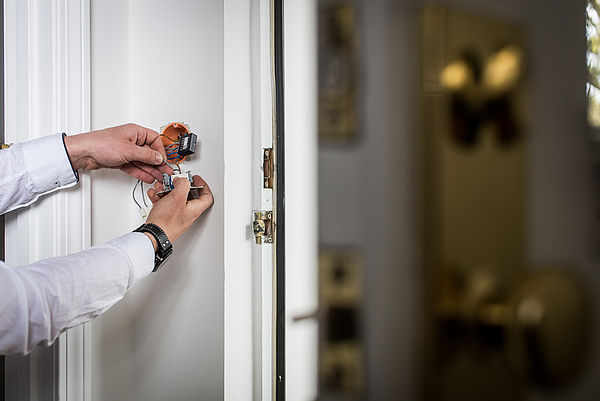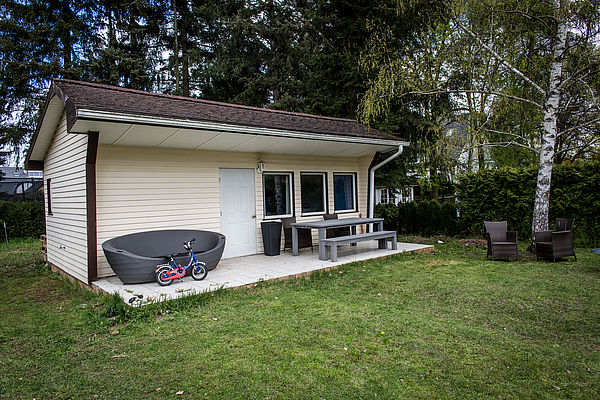Smart southern dream at the gates of Berlin
Strong and convincing arguments for the digitalSTROM Smart Home solution
“The practical and highly beneficial functionalities made possible by the digitalSTROM smart home system in everyday life have quite convinced us all in the family.” With these words, the well-known TV and radio journalist Sven Oswald describes how he decided to opt for the digitalSTROM and ist solutions. Be it shutters, lights or the in-house sound system: almost everything in the house is intelligently connected thanks to our system. And even the last, not yet interconnected aspects of the house are soon to follow. Indeed, there is no problem with it. “The modular structure of the digitalSTROM Smart Home system allows a step-by-step expansion of our smart home, depending on our mood and financial situation,” as Sven Oswald likes to explain.

Dreaming of an interconnected home
Upon first seeing the two-storey Red Cedar House with its typical veranda circling the property, one might associate it more with the bucolic environment of the southern USA rather than Kleinmachnow just to the south of Berlin. It’s no wonder because the picturesque wooden house in which Oswald and his family realised their dream of having their own four walls, actually comes from overseas. The previous owners, a married couple of German diplomats, had imported the house in containers from the USA in the early 2000s, having lived in a similar house for several years.

For Oswald, this house was a lucky find. Known by many Berliners among other things as presenter on the rbb (Berlin-Brandenburg Broadcasting) station Radio Eins and as a multimedia expert, the journalist had been looked for some time for a home for him and his family. On the one hand, it had to be in close proximity with Berlin, yet it also had to provide lots of space and have a garden. And of course, it had to also be interconnected.
Large house, lots of windows, central controls
For this reason, Sven Oswald had the house fitted with digitalSTROM when moving in. Alongside the desire for comfort, there were very practical reasons for this move – the house had 23 windows and two front doors. Without central and smart controls, manually operating the roller shutters that Oswald had fitted in the house for energy and safety reasons would have turned into a gargantuan task.
Smart, simple and affordable
Sven Oswald thus decided to make his new home a smart home. “I had known for quite some time that I would want a smart home if I ever bought a house,” explained Oswald. “My wife, however, was not so enthused with the idea to start with. She expected no notable benefits from it. Furthermore, she thought that the installation would involve a lot of effort and high costs and that a smart home system would only bring yet more complicated and high-maintenance technology into the house. It was important to me that it was easy to use without any tinkering, so that I could network all devices according to my ideas without special technical and programming knowledge,” described the journalist. Additionally, the installation had to be as simple and as quick as possible. This would exclude smart home systems with extra cabling where slots would first have to be knocked into the walls, thereby turning the house into a construction site. Naturally, cost also played a part. “When you’ve just bought a house, there’s initially no room in the budget for any large investments,” concludes Oswald.
System development and expansion on budget
As digitalSTROM uses regular power lines in the house to communicate with devices, the essential foundation for the smart infrastructure is already established with the installation of the central network components. This can then be expanded and expanded at any time according to requirements and, above all, according to the budget available. All devices that are to be integrated into the network now or later only have to be connected directly to the power lines using the corresponding digitalSTROM terminals. In this way, digitalSTROM interconnects different electrical devices regardless of manufacturer. This includes lights, switches, roller shutters, doorbells, fridges and electrically controlled heating and water outlets, as well as sensors such as smoke and motion detectors or weather stations. Even devices with IP interfaces like tablets, consumer electronics or modern kitchen devices can be integrated into the smart home via simple plug and play.
Simple configuration
The set-up and configuration as well as individual connections of device functions are carried out via the easy-to-use user interface from digitalSTROM.

Using digitalSTROM’s apps, the desired home scenarios and processes can be set up. The range of functions can be extended easily and at any time using software. As an example, Oswald uses digitalSTROM’s timer switch app to automatically activate the roller shutter motors, which dynamically adjusts the times for the raising and lowering of the shutters to the current sunrise and sunset times. Equally, Oswald can control the shutters any time and more importantly directly with the smartphone app, as he demonstrated from his garden. Yet naturally, the journalist uses the smart home system not only for comfortably controlling the shutters, but also the inner and exterior lighting. While the automatic activation of the outdoor lights also depends on seasonal lighting conditions, Oswald has already configured the first lighting moods in his spacious house.
The appropriate operation for everyone
But do you always have to get out your smartphone? “It’s hardly necessary. I can also retrieve the different moods using the traditional light switch on the wall,” explains Oswald. To do this, he replaced the light switches at central points with commercially available sensors and had them fitted with digitalSTROM terminals.

Equipped this way, the pushbuttons become individually configurable, linkable control devices for the smart home. Oswald has configured the light switch in the kitchen area in such a way that when he taps the switch once, the kitchen ceiling lighting comes on as expected. To dim the kitchen lights, he simply holds the button down. If he presses the button twice, it activates all the lights. Pressing it three times only turns on 40% of the ceiling light – because that’s quite enough if you just want to grab something quickly from the kitchen.
The button of Oswald’s bedside lamp next to his bed works according the same principle yet with different settings. Using this, he can control not only the light, but also the entire room lighting and the roller shutters of his bedroom. “The user philosophy of digitalSTROM was for me a strong argument for this system – so much so because my wife would not have taken to complicated control functions. Now everyone can switch on the light as usual with the at the wall, but also with the same button, and with just a few more taps, they can retrieve different comfort functions.
Everybody got used to it right away. My three and five year-old children enjoy using it, and when their grandmother comes to visit, we don’t need to explain it to her.” The “leaving the house button” by the front door also follows the equally intuitive and practical principle. Whoever leaves the house last can deactivate all electrical devices no longer needed on, roll down the shutters and activate the alarm system, all with just one long press down.
“The modular construction of the network and the decentralised operation via a button provides us with yet another safety feature,” explains the media specialist. “If the Internet goes off or something happens with the server, all important user functions are still available nonetheless. The smart home is still functional. There is therefore no single point of failure.
With digitalSTROM you can do anything, anytime
After installation, Oswald is happy to keep himself busy with the configuration of his interconnected home. Describing his life in the smart home, the presenter says: “First of all, you have to grasp all the possibilities that you have with digitalSTROM – in principle, you can do anything you can imagine with digitalSTROM.”

The radio presenter feels best equipped for the smart future. His next plans concern the summer house. “The cabin gets its electricity from a branch of the main house’s electricity supply. Therefore, we only need to connect the desired lamps and other devices we want to add to the network with the digitalSTROM terminals.” In addition, the garage door and a designated roller door in the new fence are going to be connected via digitalSTROM. “The practical advantages that the system has provided us in our daily lives have surprised us all,” says Oswald.

